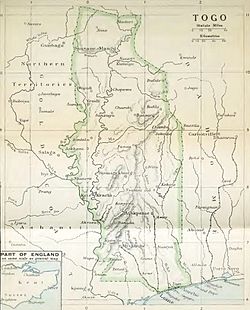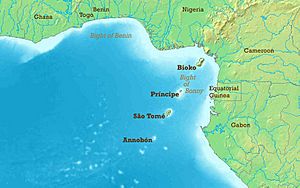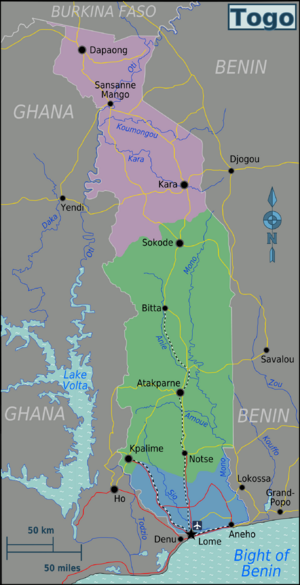Affair of Khra facts for kids
Quick facts for kids Affair of Khra |
|||||||
|---|---|---|---|---|---|---|---|
| Part of the Togoland Campaign of the First World War | |||||||
 Map of Togoland, 1914 |
|||||||
|
|||||||
| Belligerents | |||||||
|
|||||||
| Commanders and leaders | |||||||
| Frederick Bryant A. F. Redfern H. S. Collins R. Castaing |
Hans Georg von Doering | ||||||
| Units involved | |||||||
| Gold Coast Regiment Tirailleurs Sénégalais |
Paramilitary and police forces | ||||||
| Strength | |||||||
| British: 300 France: 158 |
German Empire: 460–560 | ||||||
| Casualties and losses | |||||||
| Britain 31 France: 44 |
German Empire: 13 | ||||||
The Affair of Khra (also called Chra) was a battle fought on 22 August 1914. It took place near the Khra River in German Togoland. British and French soldiers fought against German police forces. This battle was part of the Togoland Campaign during the First World War.
The German defenders tried to stop the Allied advance. They placed hidden explosives (mines) near the river and blew up the bridges. They also dug trenches around the village of Khra. From these positions, they used rifles and three hidden machine-guns to defend the river crossing. The first attack by British and French troops was pushed back. The Germans then planned a counter-attack, but many of their soldiers refused to fight, so the attack never happened.
The Germans retreated during the night to Kamina. They were worried that other British and French troops might cut off their escape. They also thought the Allied forces were much larger than they actually were. The Allied invaders waited for two days. Then, they continued their advance towards Kamina. On 25 August, two Germans met them at Glei and offered to surrender. The British commander demanded an unconditional surrender, meaning no special conditions. The Germans accepted this the next day, and the fighting stopped. Togoland was then managed by France and Britain together for the rest of the war. After the war, Togoland was divided. The western part, controlled by the British, joined Ghana in 1957. French Togoland became the independent country of Togo in 1960.
| Top - 0-9 A B C D E F G H I J K L M N O P Q R S T U V W X Y Z |
Why the Battle Happened
War Begins: A Global Conflict
When the First World War started, the British government had a plan. They wanted to control the seas to protect their trade routes. They also wanted to attack German bases that helped German ships. These bases included places where German ships could get coal and wireless stations that sent messages.
A German wireless station in Togoland was very important. It was located near the British colony of Gold Coast (now Ghana). This powerful station at Kamina connected Germany with its colonies in West Africa and South America. It also helped German ships in the Atlantic Ocean. Taking control of this station was a key goal for the British.
Togoland's Situation
At the start of the war, the German leader in Togoland was Major Hans Georg von Doering. He had police and border guards, but no regular army. He suggested that Togoland stay neutral, meaning it would not take part in the war. This idea was based on an old agreement called the Congo Act of 1885.
However, the British and French demanded that Togoland surrender without conditions. The Germans left the capital city of Lomé and the coastal areas. Doering sent a wireless message to Germany, explaining his plan to retreat to Kamina. The British intercepted this message. This led them to approve attacks on Kamina on 9 August. British and French forces began invading Togoland on 12 August.
Early Moves in Togoland
British forces from the Gold Coast, led by Lieutenant-Colonel F. C. Bryant, invaded Togoland from the west. French forces from French Dahomey invaded from the east. On 6 August, French police took over customs posts. By 8 August, they captured the town of Aného. About 460 German colonists and local soldiers (Askaris) retreated inland. They forced civilians to join them and called up reserve soldiers.
The French moved towards Porto Seguro and Togo. They stopped when Lomé, the capital of Togoland, surrendered to the British. The British had demanded Lomé's surrender on 6 August. The Germans left Lomé for Kamina, about 120 km (75 mi) inland. They surrendered the coastal area up to the Khra River to prevent the British navy from bombing Lomé.
By 12 August, the coast and Lomé were under Allied control. The Germans had retreated to Kamina, about 160 km (100 mi) inland. This wireless station was built on hills near Atakpamé. The only ways to get inland were by railway and road. These paths went through thick jungle. The Allied advance was slow because the Germans destroyed railway bridges. This made it hard to move troops and supplies.
On 15 August, German Captain Georg Pfähler and 200 soldiers were ambushed at the Affair of Agbeluvoe. Pfähler was killed, and the Germans suffered many losses. They fled, leaving 48 km (30 mi) of railway intact. On 17 August, 150 French Tirailleurs Sénégalais (African soldiers) joined the British force.
Getting Ready for Battle
Operations in Other Areas
In early August, small groups of British police from the Gold Coast moved into northern Togoland. They occupied towns like Yende without a fight. Other small groups of British police also invaded northern Togoland at different points. Further south, 48 men occupied Ho on 17 August. British officers cut the railway line between Lomé and Palime. The Germans in Palime soon left and blew up bridges.
French forces also invaded northern Togoland from French Dahomey. They fought with German defenders but faced strong resistance. More French groups followed. About 200 Togolese soldiers deserted, and many others retreated. Local leaders quickly stopped supporting the Germans. By 23 August, French forces reached Sansane Mangu. British troops from Gambaga also arrived there on 18 August.
Allied Plans
On 19 August, Lieutenant-Colonel Bryant began the main Allied advance. He sent messages to other Allied commanders, telling them he expected to reach the Amuchu River by 26 August. He wanted them to be close to Kamina by then. Bryant believed local civilians would help the British and French. Many civilians had been forced by the Germans to oppose the Allies. But as soon as the Allies invaded, civilians were happy to help.
Major Maroix led 368 French and Senegalese troops with artillery. They started advancing on Kamina on 22 August. Another British column, called the Krachi Column, arrived from 16 to 18 August. They used canoes to cross the Volta River and then marched towards Kpandu.
The battle at Agbeluvoe was seen as a big defeat for the Germans by local people. It briefly slowed the British advance. The Germans had about 1,500 men, but they struggled to get information about the British. Berlin kept telling them to protect the wireless station. In the first three weeks of August, the Kamina station sent 229 messages between Germany and its colonies.
On 21 August, British scouts reached the Khra River. The Germans blew up the bridge and set off two mines. They then fired on the scouts with machine-guns. The scouts were able to see the German defenses and report back to Bryant. They told him the Germans had dug trenches around the village, about 500 meters (550 yd) north of the bridge.
Allied Attack Plan
The area was covered in thick bush, making it hard to see more than a few yards. This made it difficult to keep direction, support each other, or use machine-guns effectively. Bryant decided to attack from two directions. Skirmishers (soldiers spread out in a loose line) would go first.
- Right Flank (near the railway): Part of G Company of the Gold Coast Regiment and French soldiers would attack around the German left side. Another part of the Pioneer Company would attack the Germans head-on.
- Left Flank: Half of C Company, I Company, and three guns would attack around the German right side. The other half of C Company would attack the Germans head-on. The guns would provide support. Seventeen French Senegalese soldiers joined the attack near the railway.
German Defenses
The Germans chose Khra as the place to defend Kamina. Khra was west of the railway, about 140 meters (150 yd) wide and 365 meters (400 yd) long. The railway from Khra to Kamina was open for supplies and reinforcements. The German force of about 440 troops had three days to dig in before the Allies arrived on 21 August. They dug trenches around the village and to a nearby railway cutting. They placed three or four machine-guns on the sides to cover all attack routes. They also mined the road and railway bridges, which were about 500 meters (550 yd) south of Khra.
The Battle of Khra
G Company and the French soldiers moved through the bush on the German left side. Around 11:00 a.m., they were stopped by heavy rifle and machine-gun fire from the German trenches. Both sides fired at each other until 3:30 p.m. Lieutenant G. M. Thompson believed they had enough firepower and ordered an attack. However, German fire increased, and the attack stopped about 45 meters (50 yd) from the German trenches. Thompson, Major Maroix, and many soldiers were killed or wounded. The remaining soldiers retreated. Almost all the French Senegalese soldiers were killed or wounded; 12 dead were found around Thompson's body.
On the left side, I Company moved around the German right flank. They faced a lot of small-arms fire. They found more trenches and did not have enough men to risk an attack. When it got dark, they pulled back and dug in along the riverbed, about 275 meters (300 yd) west of the village. Two British guns fired from 1,189 meters (1,300 yd) away, but it was hard to see the results.
The German forces were ordered to counter-attack, but many soldiers refused or ran away. The three German machine-guns had fired thousands of rounds from their hidden spots. They were the main reason the German defense was so strong. At first, the Germans were worried about the British gunfire. But they found that their own fire kept the Allies back. The attack on the German left flank was a surprise. But a third company of German reinforcements arrived by train from Kamina, which helped push back the attack.
The order to retreat was given overnight. The German defenders were not happy about this. They believed they could have held off the Allies for much longer. They had only 13 casualties. The British soldiers found facing machine-gun fire very difficult. Their own machine-guns were not as effective. During the night, Bryant prepared to attack again at dawn. He ordered his troops to dig in and sent more men to I Company on the left flank.
After the Battle
Who Was Hurt
About 450 British and other Allied troops fought in the battle. They had 75 casualties, which means about 17% of their force was killed or wounded. One British and one French officer were killed. Five British and sixteen French soldiers were also killed. Two British officers, one French non-commissioned officer (NCO), 23 British soldiers, and 20 French soldiers were wounded. Six porters (people carrying supplies) were also wounded. The Germans had 13 casualties.
What Happened Next
The British sent out patrols to Glei and the Amu River. They wanted to check reports that the Germans had stopped retreating. The main Allied force stayed at Khra from 23 to 24 August. They brought up supplies and sent the wounded back to Lomé. This happened after the railway was fixed and an ambulance train was set up. Few soldiers were sick, even though they were often wet from the climate.
Bryant expected the Germans to make their main stand at Kamina. He ordered the Krachi Column to move to Lomé and join the main force. On the night of 24/25 August, explosions were heard from Kamina. The next day, the wireless masts, usually visible from Glei, could not be seen. The main force advanced and reached Glei by 10:30 a.m. Scouts reached the Amu River and found that the Germans had blown up the road and rail bridges.
At 4:00 p.m., Major von Roebern and an interpreter came to Glei under a white flag, offering to surrender. Bryant demanded an unconditional surrender. He ordered his force to cross the river and advance to Amuchu. But the river flooded during the night, and the crossing was not finished until 26 August.
Bryant reached Amuchu with an advance group at 10:30 a.m. on 26 August. He met two German officers who offered an unconditional surrender. A civilian volunteer went to Kamina to arrange the surrender details. He found that the wireless transmitter had been destroyed and burned. The pause in the Allied advance at Khra had given the Germans time to send more messages. Then, Von Doering ordered the wireless station destroyed before surrendering his remaining 200 troops. He also surrendered three machine-guns, over 1,000 rifles, and about 320,000 rounds of ammunition.
The Krachi Column advanced and reached Palime on 23 August. They had faced no opposition, even though the land was difficult. The roads were in good condition, and they got supplies from welcoming civilians. The French column under Maroix also advanced and met minor resistance from 22 to 23 August. They entered Kamina on 27 August.
Images for kids






